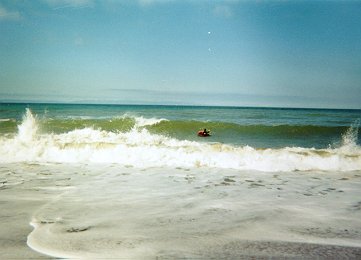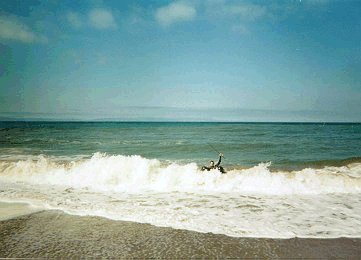Launching you float tube in saltwater takes quite a bit more caution than launching in freshwater. The main reason of course are waves. Waves can turn a potentially good day of tubing into a wet nightmare. Other factors are also at play in the ocean. Ocean current can affect your speed and maneuvering as can the wind and swells. On windy days the ocean can also easily whip up relentless white caps that will ensure that you get wet. My experiences have helped me develop a set of guidelines to follow when launching in the ocean. Anyone who plans to float tube the ocean should pay attention to some of the more troubling problems that I have had.
When launching off of the beach examine how the waves are breaking. A wave will generally break within 5-10 feet of the place where the wave before it broke. This area is called the break zone. The break zone is important because while you are in it you are in the most danger of getting wet or flipped. Once you crest the break zone you can be at ease and not worry greatly about waves continuing to break on you. Once you have a general idea where the break zone is you will want to look at the wave itself. There are a couple of things to look for. The two most important things to look for are size and shape. Shape can matter more because a smaller wave that is barreling (breaking clean round) will cause you more grief than a wave that is crumbling (slower break,  whitewater rolls off the top, slope of waves isn't as steep). A crumbling wave can be broken through though it will leave you wet. A tubing wave, however, will lift and flip you if it is too large (I learned that lesson the hard way). I will go out in crumbling breaks if the face is less than three-four feet. Waves that are barreling I usually draw the line at 3ft and will go out in anything less. Start out with small waves and if you feel comfortable move up. I surf a lot and used to take swimming in high school so my biggest fear isn't drowning but losing or breaking my equipment.
whitewater rolls off the top, slope of waves isn't as steep). A crumbling wave can be broken through though it will leave you wet. A tubing wave, however, will lift and flip you if it is too large (I learned that lesson the hard way). I will go out in crumbling breaks if the face is less than three-four feet. Waves that are barreling I usually draw the line at 3ft and will go out in anything less. Start out with small waves and if you feel comfortable move up. I surf a lot and used to take swimming in high school so my biggest fear isn't drowning but losing or breaking my equipment.
The next thing to consider is where to launch. The best places are of course harbors or docks but this really limits your options. Another safe place to launch in on the inside of points. The waves will be slack and you can get out with less trouble than at the point. If you are launching from a beach break watch the waves for spots that are breaking smaller or slower. The ocean bottom helps decide what size and shape waves will be so you can often times find places where the break is smaller.
After determining that you are going out and after having picked the spot you are ready to prepare to launch. First things first, make sure all your gear is fastened and put away. I have lost two nets and temporarily a fishing license (the fishing license with my hat attached somehow made it to the SB Harbor Patrol, 5 miles away, who then sent it to me in the mail) because I was too lazy to tie them down (some people never learn). Make sure your fins are tightly fastened, your reel is stowed away if you choose to do so, and all your tackle is in the float tube pockets.
Now comes the hardest part. Deciding when to launch. Most people are under the impression that you can just head out whenever you want. The reason this assumption is wrong is because the larger waves come in batches called sets. Sets vary but they are usually 4-7 waves that are noticeably larger than the usual waves. The good thing about sets is that they come in somewhat predictable time patterns. The time between sets varies from 5-25 minutes depending on the current conditions. Usually they are pretty close together so you want to get out before they hit. Another error most people make is waiting for the set to die down before launching. This will result in a good soaking because by the time they reach the break zone the next set has arrived and they get pummeled by the larger waves. The best time to launch is when a set is just beginning. Sets don't last long so by the time you begin to near the break zone they should begin to diminish. You will then be able to kick through the break zone when the waves are the smallest. Another good method is to get out into the whitewater and wait for the set to die. As long as the waves are already broken, the whitewater will only cause you minor difficulties and you will be in the best position to get through the break zone when the waves are the smallest.
When you decide to launch do so aggressively. If you take your time and try to conserve energy the waves will push you back time after time after time. Once you launch and are near the break zone kick as hard as you can to get out of the area as quickly as possible. Also, don't hesitate or rethink about going. Chances are you are already in or really close to the break zone and if the waves do come you won't have time to get out of the way so you may as well advance while you get wet rather than getting wet and having to try again. 
Dealing with the waves is not as difficult as a lot of you think. First and foremost, NEVER let a wave crash into you head-on. Always take waves towards your back. This not only keeps your front drier, but the balance of your weight is on the back of your float tube and it makes it a lot harder to flip. When a wave or whitewater is about to break on you turn your back towards it, lean as far back as you can, and kick like there is no tomorrow. If you do this properly you will be too heavy for the wave to pick up and you will slice through the wave. You will get wet, but you won't flip.
Usually I start my articles with tackle requirements/recommendations but this one I will end it with. Number one, if you are going to go through waves and whitewater use a wetsuit because waders will fill up with water. Also, a wetsuit allows you to relieve yourself with having to get out of the water, see central heating. The second thing I would recommend would be to make sure that you have a float tube that can stand up to the corrosion of saltwater. A lot of float tube were designed with only freshwater fishing in mind and will quickly deteriorate if not properly taken care of. For tackle I would suggest a baitcasting setup although a spinning setup will work for smaller fish. As far as tackle goes it all depends on what you are fishing for. I usually bring a wide assortment of plastics that can catch pretty much anything that swims the seven seas.
If you are considering float tubing the ocean you should do so. Its fun, safe, and productive. I have yet to feel my life was in any danger, including the time I was flipped and once time I have a hook puncture in my tube. Start out on calm quiet days, take some buddies with you and try to get used to the ocean (it is a lot different than a lake, trust me). Once you become confident move up and try more challenging places such as beach breaks. Always be careful not to use moderation and not over do anything.
